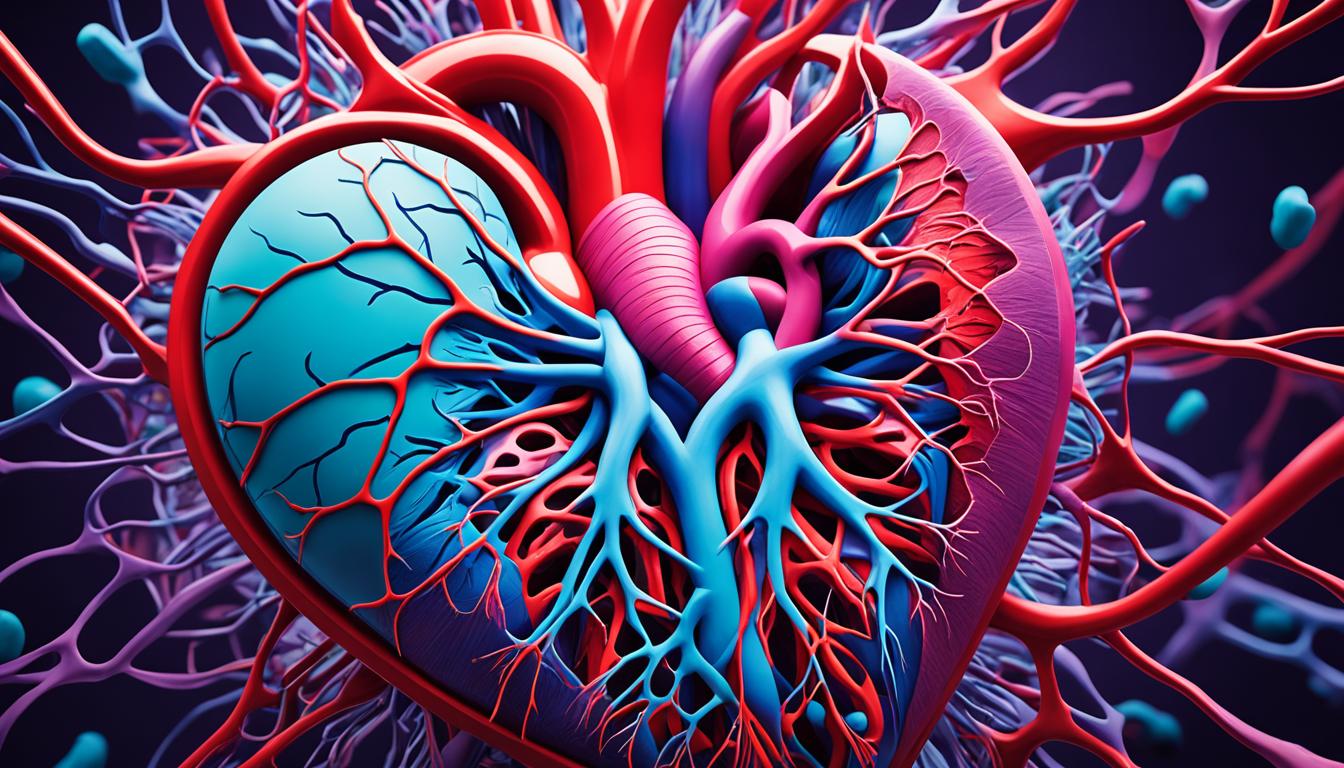Septal defect atrioventricular (AVSD) is a congenital heart problem with a hole in the heart. This hole allows too much blood to flow through the lungs. It can lead to serious issues like pneumonia and heart failure. Also, it’s linked with arrhythmia and infective endocarditis. Around 4-5% of people with heart issues have AVSD. The problem’s severity can differ. Some holes close by themselves early in life. But, larger or long-term defects may need surgery. Stem cell therapy shows promise in treating this condition.
Key Takeaways:
- Septal defect atrioventricular (AVSD) is a congenital heart defect characterized by a hole between the upper heart chambers.
- AVSD can lead to complications such as severe pneumonia, heart failure, arrhythmia, and infective endocarditis.
- It is a common type of congenital heart disease, accounting for approximately 4-5% of all cases.
- While some cases may close on their own, larger defects may require surgical intervention.
- Stem cell therapy is being explored as a potential treatment option for AVSD.
Types of Septal Defect Atrioventricular Disease
Septal defect atrioventricular (AVSD) comes in various types. These include secundum, primum, sinus venosus, and coronary sinus defects. Secundum atrial septal defect is the most common. It’s found in the middle of the heart’s upper chamber wall. Primum atrial septal defect affects the lower part and can be seen with other heart problems. Sinus venosus atrial septal defect is in the heart’s upper part and often comes with other heart shape changes. Coronary sinus atrial septal defect involves a missing piece of the heart wall between chambers.
Knowing the various forms of septal defect atrioventricular disease is very important. This knowledge helps in diagnosing and planning treatment accurately. Each type has its unique challenges and requires specific care based on its features.
Symptoms of Septal Defect Atrioventricular Disease
Symptoms of septal defect atrioventricular (AVSD) can change based on the defect’s size and seriousness.Newborns may not show any symptoms at first. Some people might not have symptoms until later in life.
Here are some of the common signs:
- Shortness of breath, especially during exercise
- Tiredness
- Swelling of the legs, feet, or belly area
- Irregular heartbeats
- Palpitations
If left untreated, these symptoms can get worse and cause problems. If you notice these signs in yourself or your child, see a doctor. They can diagnose and help manage the condition.
Recognizing the Symptoms
Shortness of breath, tiredness, swelling, and heart rhythm issues are telltale signs of atrioventricular septal defect. These warning signs can slow daily life and call for medical help. If you notice any, don’t hesitate to see a healthcare provider for advice.
| Symptom | Prevalence |
|---|---|
| Shortness of Breath | Common |
| Tiredness | Common |
| Swelling | Common |
| Irregular Heartbeats | Common |
| Palpitations | Common |
Diagnosis of Septal Defect Atrioventricular Disease
The diagnosis of septal defect atrioventricular (AVSD) is thorough. It includes many tests to confirm its presence and how severe it is.
X-ray imaging is often used in diagnosis. It can show if the heart chambers are too big and spots any problems with the pulmonary artery. This helps doctors see what changes are happening due to the AVSD.
Doctors also do a detailed heart exam. They listen for unusual sounds and check the heart’s rhythm. This helps in diagnosing AVSD by giving key information on the heart’s condition.
Echocardiography, using ultrasound, is crucial in diagnosing AVSD. It makes detailed heart images. This lets doctors learn about the defect’s size and characteristics.
During echocardiography, a transducer sends sound waves to the heart. These waves bounce back as images. This process shows the septal defect clearly, helping with treatment choices.
Detailed Diagnosis Process:
- Medical evaluation, including a complete medical history and physical examination.
- X-ray imaging to identify enlarged heart chambers and abnormalities in the pulmonary artery.
- Thorough heart examination, including listening for abnormal sounds and assessing heart function.
- Echocardiography to create detailed images of the heart and confirm the presence of a septal defect.
In conclusion, diagnosing septal defect atrioventricular (AVSD) needs a full look with X-rays, a heart exam, and echo tests. These tests are vital for pinpointing and understanding a septal defect. They help make the right choices for treating and managing AVSD.
Treatment of Septal Defect Atrioventricular Disease
The treatment method for septal defect atrioventricular (AVSD) varies by its size and harshness. Small defects might close on their own without any intervention. But, bigger defects or those with symptoms need surgery to close the hole.
Stem cell therapy is a new treatment choice for AVSD. Doctors are studying how stem cells could help the heart heal and work better in people with AVSD. This could be a promising option for patients looking for a less invasive method.
Specialized pediatric cardiologists are key in treating AVSD in children. They are skilled in diagnosing, treating, and monitoring kids with this heart issue. These doctors help young patients from the first check-up to ongoing care, aiming for the best health results.
Conclusion
Septal defect atrioventricular (AVSD) is a common heart defect from birth. It involves a hole between the upper heart chambers. Smaller defects might fix themselves, but larger ones need surgery. This prevents problems and makes life better for those affected. Surgery closes the hole to fix blood flow, especially during symptoms or complications.
The medical community is looking at other ways to treat AVSD. Stem cell therapy is showing potential in fixing heart tissue. This new approach aims to heal and improve the heart without surgery. It gives hope for managing congenital heart defects better.
Early diagnosis and treatment are key in AVSD management. Specialists in pediatric cardiology are critical. They diagnose accurately, suggest the right treatments, and ensure follow-up care. With better surgery and new treatments like stem cells, life for those with AVSD is looking up. There’s more hope for a better quality of life.

